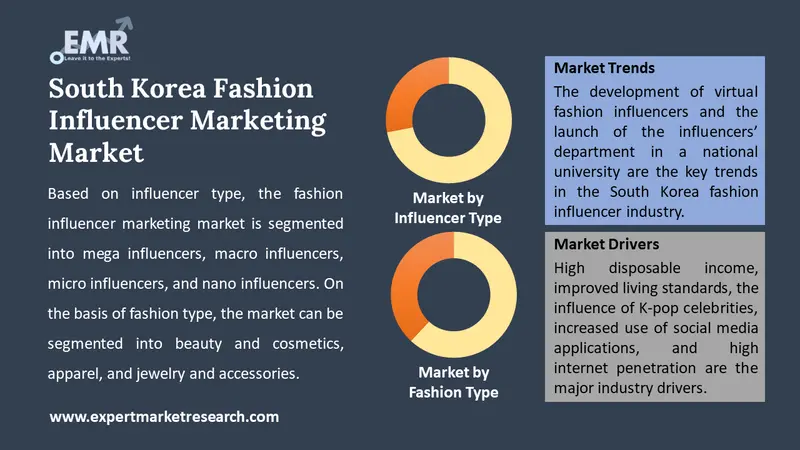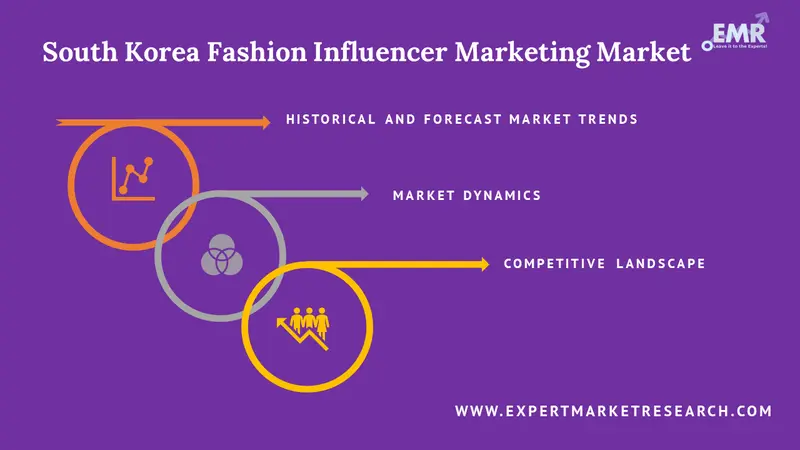
Consumer Insights
Uncover trends and behaviors shaping consumer choices today
Procurement Insights
Optimize your sourcing strategy with key market data
Industry Stats
Stay ahead with the latest trends and market analysis.
The South Korea fashion influencer marketing market size reached a value of more than USD 2.89 Billion in 2025. The South Korea Fashion influencer marketing industry is expected to grow at a CAGR of 17.30% between 2026 and 2035, reaching a value of USD 14.25 Billion by 2035.
Base Year
Historical Period
Forecast Period
Compound Annual Growth Rate
17.3%
Value in USD Billion
2026-2035
*this image is indicative*
Fashion influencers provide businesses with a different way to engage in product sales and help understand the preferences of their customers. Companies ask their preferred influencers to provide content on jewellery, apparel, cosmetics, skincare, and footwear via comments, polls, and direct messages. This makes it easier for influencers to provide companies with deep insights into customer desires and expectations. They are encouraged by brands to participate in fashion shows, designer dinners, events, special excursions, and social media photo shoots wearing their clothing or other products. If a salary is involved, the influencer may be compelled to designate such posts as paid or sponsored material. Forbes, a business publication, called fashion influencers "the new celebrity endorsements." They are referred to as "IT girls" and "IT boys" by social media.
The Growing Trend of Appointing Virtual Fashion Influencers in South Korea
In December 2021, convenience store franchise GS25 appointed Rozy, South Korea's first virtual social media influencer, to promote the business's products and promotions. Rozy is a digitally made intern agent that works in a fashion and art plaza in Dongdaemun district, South Korea's fashion and tourism hub, to promote a variety of independent fashion firms. Over 123,000 people follow Rozy. Customers would hear from Rozy via content based on the metaverse, a hybrid of the real world and the virtual world that offers first-hand experiences. Other factors such as high disposable income and high standard of living motivate consumers to spend on the goods and services promoted by influencers, thereby bolstering the fashion influencer marketing industry of South Korea.
South Korean University Launches the Country’s First Influencer Department Due to the Growing Impact of Social Media Influencers on Consumers
Daegu Cyber University established the nation's first influencer department earlier this year with the goal of fostering industry professionals and content-based social media influencers. Planning creatively, recording, and editing procedures are the most crucial abilities for content providers. However, students must also understand who will be in charge of the commercial aspects of the position, such as contacts with advertising or a larger audience. The emergence of OTT media services like Netflix, Disney+, and Korea-based Wavve, Watcha, and Tving has expanded the field of competition for makers of digital content beyond platforms like YouTube and TikTok, thereby augmenting the fashion influencer marketing market in South Korea.
K-Pop Idols' Influence in Setting Fashion Trends and Influencing the Masses
The popularity of South Korean culture has dramatically increased in recent years. The popularity of drama series and its particular musical genre, K-pop, which is now regarded as a genre unto itself, are sometimes connected to the steady growth of its culture. When referring to K-pop idols who are regarded as icons in the business, the words "it boy" and "it girl" are resurfacing and are often used. One of the other characteristics of K-pop celebrities is their capacity to change and command everyone's attention and set various fashion trends while they're in front of the camera or working behind the scenes.
The omnipresence of K-pop fans is driving the fashion influence industry of South Korea. BTS Jimin is regarded as the "IT boy" of the K-pop industry for his unique style and personality. BTS Park Jimin has been continuously ranking no. 1 in the brand reputation rankings released by the Korean Business Research Institute, which makes him the most desired brand ambassador by various brands.
South Korea is one of the top smartphone users in the world. The internet penetration is approximately 97% aiding in the increased usage of e-commerce, online banking, and social media, among others. High-speed communications networks and world-class IT infrastructure enable tech-savvy customers to actively discuss new product launches and fashion trends in the country.

Read more about this report - REQUEST FREE SAMPLE COPY IN PDF
The EMR’s report titled “South Korea Fashion Influencer Marketing Market Report and Forecast 2026-2035" offers a detailed analysis of the market based on the following segments:
Market Breakup by Influencer Type
Market Breakup by Fashion Type
Micro influencers provide instant marketing of a business's goods or services with high engagement rates. Because micro influencers have a larger following than nano influencers, marketers can more easily identify the demographics and mindset of an audience in a particular area, enabling them to create more specialised goods, artwork, and information. As their audiences relate to them, micro influencers may also assist fashion firms in strengthening their trustworthiness, which is crucial for creating strong consumer relationships. Nano influencers also ensure a decreased chance of connecting with fake followers and foster closer connections with their audiences, which results in more filtered leads for businesses. Additionally, using nano influencers for marketing gives businesses and agencies a more cost-effective choice, creating market expansion prospects.
The growth of fashion influencer marketing industry of South Korea is expected to be aided by the factors such as high penetration of internet, increased consumer awareness due to the growing popularity of social media, and globalization among others.
In all retailing sectors, including the food, fashion, and cosmetics industries, the Rozy syndrome is quite prevalent. In August of 2021, Sidus Studio X developed Rozy, a virtual person made with 3D technology and facial data that was well-liked by MZ generations. Rozy has promoted environmentally friendly initiatives as well. She took part in the GoodNeighbors "It's all right" challenge and said, "It's acceptable to reject straws for Earth that becomes heated every year." In May, she also went to the Refill Station Almang store. She also took part in the "Go Go Challenge", an event hosted by the Ministry of the Environment to encourage the plastic-free movement.
On the basis of fashion type, all the segments seem to perform well during the forecast period owing to the globalization as the access to the global fashion trends grew people, especially MZ generation follow the fashion influencers on social media platforms to stay up to date with latest trends.

Read more about this report - REQUEST FREE SAMPLE COPY IN PDF
Lotte Group (Daehong Communications) - Daehong Communications, a subsidiary of South Korean giant Lotte Group is a comprehensive marketing solutions provider established in 1982, has dominated the market by developing countless effective campaigns based on unparalleled competitiveness in fields such as ad planning and production, marketing, brand consultancy, digital marketing, promotion, and design. Daehong Communications has led the industry since its founding. Daehong Communications provides clients with solutions based on the latest trends, from performing accurate diagnoses on marketing situations for businesses looking to launch powerful campaigns that can attract customers and change the market. The firm has its headquarters in Seoul, South Korea.
Hashmeta Pte Ltd - Hashmeta is a digital marketing firm established in 2012. In addition to BSH Bosch Home Appliances, NTUC Social Enterprise, NKF, SAFRA, IMDA, CapitaLand, SPH Reit, CapitaLand Mall Asia, they have collaborated with hundreds of other well-known companies. Hashmeta is based in Singapore and has offices there as well as in Vietnam, Malaysia, Indonesia, Thailand, and China. By offering digital marketing services and solutions, they simplify the marketing process. Hashmeta runs a number of internet marketing tools, such as the influencer marketplace StarNgage and the fashion aggregator and shopping app ShopperBoard.
*Please note that this is only a partial list; the complete list of key players is available in the full report. Additionally, the list of key players can be customized to better suit your needs.*




*While we strive to always give you current and accurate information, the numbers depicted on the website are indicative and may differ from the actual numbers in the main report. At Expert Market Research, we aim to bring you the latest insights and trends in the market. Using our analyses and forecasts, stakeholders can understand the market dynamics, navigate challenges, and capitalize on opportunities to make data-driven strategic decisions.*
Get in touch with us for a customized solution tailored to your unique requirements and save upto 35%!
In 2025, the South Korea fashion influencer marketing market attained a value of nearly USD 2.89 Billion.
The market is projected to grow at a CAGR of 17.30% between 2026 and 2035.
The market is estimated to witness a healthy growth in the forecast period of 2026-2035 to reach USD 14.25 Billion by 2035.
High disposable income, improved living standards, the influence of K-pop celebrities, increased use of social media applications, and high internet penetration are the major industry drivers.
The development of virtual fashion influencers and the launch of the influencers’ department in a national university are the key trends in the South Korea fashion influencer industry.
The dominant types of fashion influencer marketing in the industry are mega influencers, macro influencers, micro influencers, and nano influencers.
The major players in the industry Lotte Group (Daehong Communication), Hashmeta Pte Ltd., AXJ International Pte Ltd, Market It Co., Ltd., S Marketing & Communications Co,.Ltd, The SMC Group, and Admax Co., Ltd., among others.
Explore our key highlights of the report and gain a concise overview of key findings, trends, and actionable insights that will empower your strategic decisions.
| REPORT FEATURES | DETAILS |
| Base Year | 2025 |
| Historical Period | 2019-2025 |
| Forecast Period | 2026-2035 |
| Scope of the Report |
Historical and Forecast Trends, Industry Drivers and Constraints, Historical and Forecast Market Analysis by Segment:
|
| Breakup by Influencer Type |
|
| Breakup by Fashion Type |
|
| Market Dynamics |
|
| Competitive Landscape |
|
| Companies Covered |
|
Datasheet
One User
USD 2,499
USD 2,249
tax inclusive*
Single User License
One User
USD 3,999
USD 3,599
tax inclusive*
Five User License
Five User
USD 4,999
USD 4,249
tax inclusive*
Corporate License
Unlimited Users
USD 5,999
USD 5,099
tax inclusive*
*Please note that the prices mentioned below are starting prices for each bundle type. Kindly contact our team for further details.*
Flash Bundle
Small Business Bundle
Growth Bundle
Enterprise Bundle
*Please note that the prices mentioned below are starting prices for each bundle type. Kindly contact our team for further details.*
Flash Bundle
Number of Reports: 3
20%
tax inclusive*
Small Business Bundle
Number of Reports: 5
25%
tax inclusive*
Growth Bundle
Number of Reports: 8
30%
tax inclusive*
Enterprise Bundle
Number of Reports: 10
35%
tax inclusive*
How To Order

Select License Type
Choose the right license for your needs and access rights.

Click on ‘Buy Now’
Add the report to your cart with one click and proceed to register.

Select Mode of Payment
Choose a payment option for a secure checkout. You will be redirected accordingly.
Gain insights to stay ahead and seize opportunities.

Get insights & trends for a competitive edge.

Track prices with detailed trend reports.

Analyse trade data for supply chain insights.

Leverage cost reports for smart savings

Enhance supply chain with partnerships.

Connect For More Information
Our expert team of analysts will offer full support and resolve any queries regarding the report, before and after the purchase.
Our expert team of analysts will offer full support and resolve any queries regarding the report, before and after the purchase.
We employ meticulous research methods, blending advanced analytics and expert insights to deliver accurate, actionable industry intelligence, staying ahead of competitors.
Our skilled analysts offer unparalleled competitive advantage with detailed insights on current and emerging markets, ensuring your strategic edge.
We offer an in-depth yet simplified presentation of industry insights and analysis to meet your specific requirements effectively.
Share